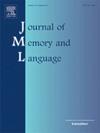用神经语言模型学习填空依赖性:测试挪威语和英语的岛屿敏感性
IF 3
1区 心理学
Q1 LINGUISTICS
引用次数: 0
摘要
人类的语言输入通常被认为是贫乏的,相对于儿童诱导的复杂结构概括的语言证据。语言习得领域目前正在讨论各种学习算法能否准确地从输入中获得目标泛化。越来越多的研究探索神经语言模型(NLMs)是否可以诱导出英语中填充-间隙依赖关系(fgd)的类人概括,包括它们分布的岛约束。基于选择测试用例的积极结果,一些作者认为可以在没有特定领域学习偏差的情况下学习相关的概括(Wilcox et al., 2023),尽管其他研究人员对这一结论提出异议(Lan et al., 2024b;Howitt et al.,2024)。以前的工作只关注于英语,但是关于填空依赖的可学习性的更广泛的主张只能基于多种语言和依赖类型。为了解决这一差距,我们比较了nlm在英语和挪威语中学习FGDs限制的能力。我们的结果是混合的:它们表明,尽管这些模型获得了关于两种语言中填充-间隙依赖关系的一些复杂的概括,但它们的概括仍然与人类的不同。当在结构复杂的环境中进行测试时,模型有时会采用比人类更狭窄的泛化,或者以非人类的方式过度泛化。我们的结论是,目前的证据并不支持在没有特定领域偏见的情况下可以学习fgd和岛屿约束的说法。本文章由计算机程序翻译,如有差异,请以英文原文为准。
Learning filler-gap dependencies with neural language models: Testing island sensitivity in Norwegian and English
Human linguistic input is often claimed to be impoverished with respect to linguistic evidence for complex structural generalizations that children induce. The field of language acquisition is currently debating the ability of various learning algorithms to accurately derive target generalizations from the input. A growing body of research explores whether Neural Language Models (NLMs) can induce human-like generalizations about filler-gap dependencies (FGDs) in English, including island constraints on their distribution. Based on positive results for select test cases, some authors have argued that the relevant generalizations can be learned without domain-specific learning biases (Wilcox et al., 2023), though other researchers dispute this conclusion ((Lan et al., 2024b; Howitt et al.,2024). Previous work focuses solely on English, but broader claims about filler-gap dependency learnability can only be made based on multiple languages and dependency types. To address this gap, we compare the ability of NLMs to learn restrictions on FGDs in English and Norwegian. Our results are mixed: they show that although these models acquire some sophisticated generalizations about filler-gap dependencies in the two languages, their generalizations still diverge from those of humans. When tested on structurally complex environments, the models sometimes adopt narrower generalizations than humans do or overgeneralize beyond their input in non-human-like ways. We conclude that current evidence does not support the claim that FGDs and island constraints on them can be learned without domain-specific biases.
求助全文
通过发布文献求助,成功后即可免费获取论文全文。
去求助
来源期刊
CiteScore
8.70
自引率
14.00%
发文量
49
审稿时长
12.7 weeks
期刊介绍:
Articles in the Journal of Memory and Language contribute to the formulation of scientific issues and theories in the areas of memory, language comprehension and production, and cognitive processes. Special emphasis is given to research articles that provide new theoretical insights based on a carefully laid empirical foundation. The journal generally favors articles that provide multiple experiments. In addition, significant theoretical papers without new experimental findings may be published.
The Journal of Memory and Language is a valuable tool for cognitive scientists, including psychologists, linguists, and others interested in memory and learning, language, reading, and speech.
Research Areas include:
• Topics that illuminate aspects of memory or language processing
• Linguistics
• Neuropsychology.

 求助内容:
求助内容: 应助结果提醒方式:
应助结果提醒方式:


